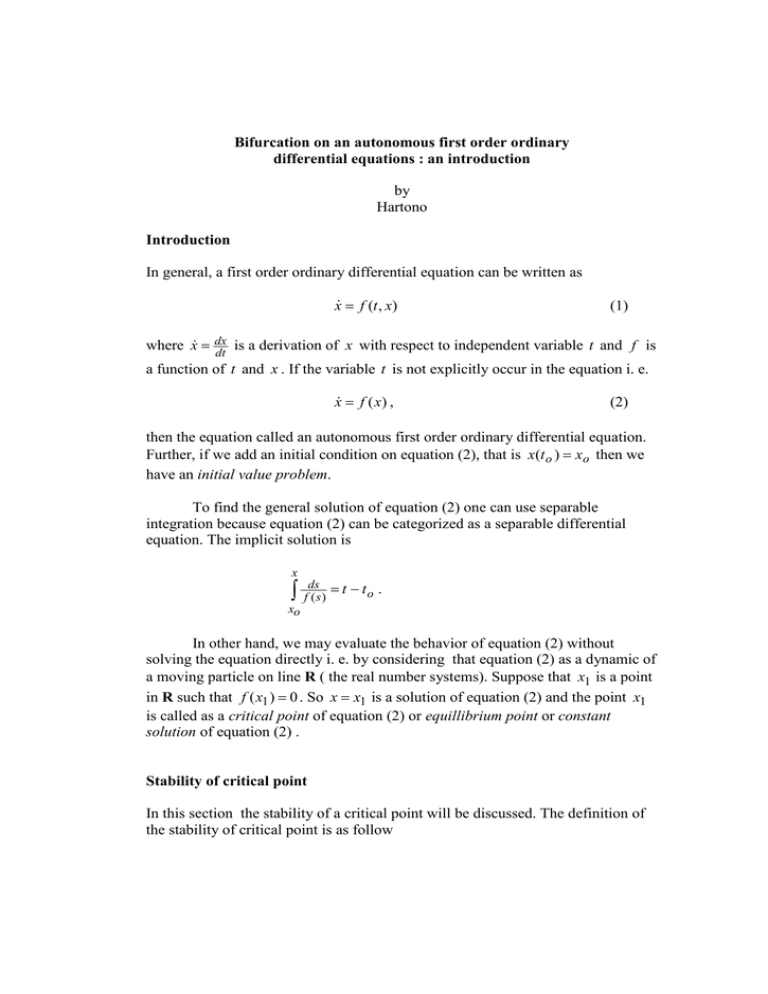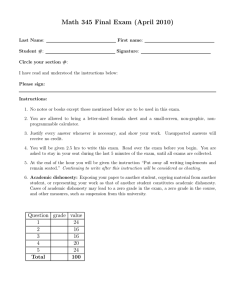Bifurcation on an autonomous first order ordinary Introduction by
advertisement

Bifurcation on an autonomous first order ordinary differential equations : an introduction by Hartono Introduction In general, a first order ordinary differential equation can be written as x f (t , x) (1) where x dx is a derivation of x with respect to independent variable t and f is dt a function of t and x . If the variable t is not explicitly occur in the equation i. e. x f (x) , (2) then the equation called an autonomous first order ordinary differential equation. Further, if we add an initial condition on equation (2), that is x(t o ) x o then we have an initial value problem. To find the general solution of equation (2) one can use separable integration because equation (2) can be categorized as a separable differential equation. The implicit solution is x fds( s) t t o . xo In other hand, we may evaluate the behavior of equation (2) without solving the equation directly i. e. by considering that equation (2) as a dynamic of a moving particle on line R ( the real number systems). Suppose that x1 is a point in R such that f ( x1 ) 0 . So x x1 is a solution of equation (2) and the point x1 is called as a critical point of equation (2) or equillibrium point or constant solution of equation (2) . Stability of critical point In this section the stability of a critical point will be discussed. The definition of the stability of critical point is as follow Definition : The critical point x1 of equation (2) is said to be stable if for any given >0, there is a >0 (depending on ) such that for every x o for which | x o x1 | , the solution x(t , x o ) of equation (2) satisfy the inequality | x(t , x o ) x1 | for all t 0 . The critical point x1 is said to be unstable if it is not stable. Further, a critical point x1 is said to be asymptotically stable if it is stable and x(t , x o ) x1 as t . point. The following theorem is related to the asymtotically stable of a critical Theorem. Suppose that f and f ' are continuous. Then the critical point x1 of equation (2) is asymptotically stable if f ' ( x1 ) 0 and unstable if f ' ( x1 ) 0 . The following example describe about the stability of a critical point. Consider the equation x x x 3 . (3) The equation (3) have three critical points i. e. x = 0, x = 1 and x = 1 as the zeros of x x3 = 0. If we write that f(x) = x x3, then f ( x) 1 3 x 2 . So, according to the theorem above, the critical point x = 0 is unstable because f (0) 1 0 and the critical points x = 1 and x = 1 are asymptotically stables because f (1) f (1) 2 0 . Bifurcation and bifurcation diagram The study of possible changes in the structure of the orbits (solutions) of a differential equation depending on parameters is called as bifurcation theory. Further, we use an example to describe what the bifurcation is. Consider the equation x x x 3 (4) where is a real parameter. The number of critical points of equation (4) depends on the real parameter . The equation (4) only has one asymptotically stable critical point i. e. x=0 for 0 and has three critical points that is x=0, x= and x = for > 0. Furthermore, x=0 is a unstable critical point and the critical points x= and x= are asymptotically stables. A differential equation is said to have stable orbit structure if the qualitative structure of the flow does not change for sufficiently small variations of the parameter. A parameter value for which the flow does not have stable orbit structure is called a bifurcation value. Thus the parameter value =0 is called as a bifurcation value for equation (4). The diagram of the relation between the number of critical points and the parameter value called as the bifurcation diagram. The bifurcation diagram of equation (4) can be described as follows. x The solid line is stable and the dush line is unstable critical points Further work In case an autonomous equation depends on a parameter, the system can be written as (5) x f (, x) where x is scalar variable ( x R) and is real parameter ( R). The equation (5) can be expanded as follows : 1. x is a scalar variable but the parameter is a vector parameter ( Rm). 2. x is a vector variable (x Rn) but the parameter is real parameter, and 3. x Rn and Rm . Reference: J. Hale and H. Kocak (1991), Dynamics and Bifurcations, New York : SpringerVerlag Inc.





![Bifurcation theory: Problems I [1.1] Prove that the system ˙x = −x](http://s2.studylib.net/store/data/012116697_1-385958dc0fe8184114bd594c3618e6f4-300x300.png)


